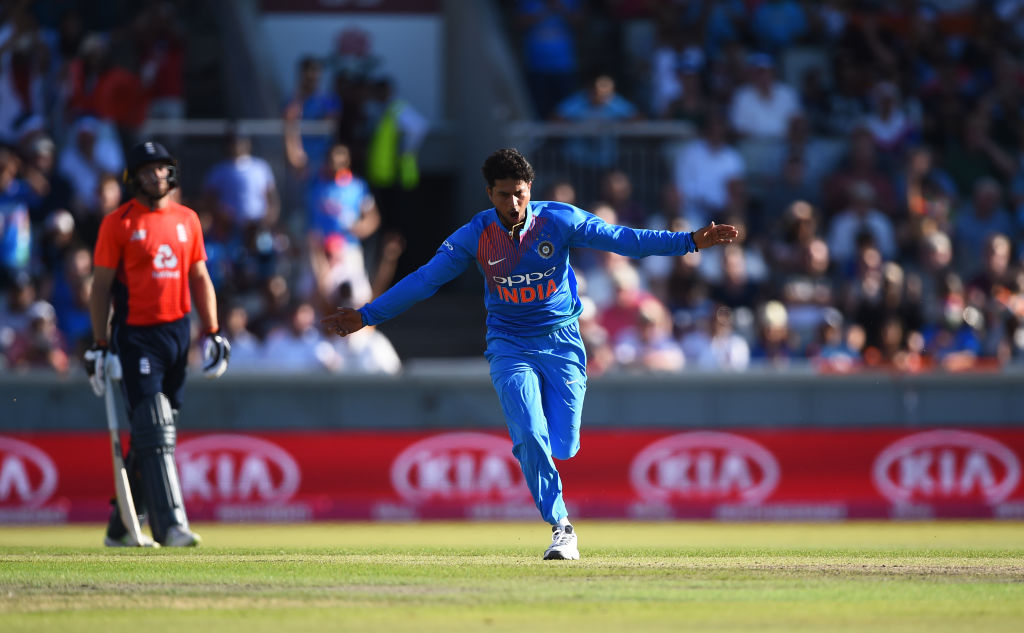India vs England | Takeaways : Virat Kohli’s bowling rotations and England’s faulty middle-over approach
After Kuldeep Yadav annihilated England single-handedly, Rohit Sharma and Virat Kohli made the run-chase a formality to give India a 1-0 lead in the ODI series. The game brought England’s flawed approach to the ODI cricket to the fore yet again, which may haunt them in next summer’s World Cup.

Virat Kohli - combining T20 and ODI captaincy in “right” way
India missed their best pacer from the South Africa tour - Jasprit Bumrah, whose unmatched ability in the death overs has been one of India’s biggest strengths in the recent years. His injury meant there was a lot of responsibility on Bhuvneshwar Kumar, who himself missed the match due to a back injury, in the series. In the absence of two pace spearheads, the onus was on the wrist-spinning duo to take the
In the 9th over, the Indian captain brought Yuzvendra Chahal into the attack and followed that up by giving the ball to Hardik Pandya and Kuldeep Yadav. Given the fact that the English openers were well set in the middle by then, Kohli threw them an oddball by changing bowlers almost in every two overs. As a result, English batsmen remained unsettled and Kuldeep took the benefit of the same and picked up a six-for today. He was also helped by the fact that English batsmen could never really understood him.
Secondly, Kohli adopted the horses-for-courses policy as he gave the ball to part-time off-spinner Suresh Raina in the middle overs when two left-handers - Eoin Morgan and Ben Stokes - were at the crease. As Raina chipped in with three economical overs, conceding a miserly 8 runs, it allowed Kohli to use the wrist-spinners after the 40th over to restrict the death-over run-flow. It was an interesting and unusual decision from the Indian skipper, especially because of the fact that he has been limited with the kind of resources he has at his disposal.
In Stokes and Buttler, England find tranquility
Trent Bridge has been the
Whenever faced with a half decent bowling attack, the lack of a Plan B was glaringly obvious but today they appeared to have one. When the boundaries dried up for the top three, the pressure got the better of them and Kuldeep was far too intelligent a bowler to not benefit from the same. But, in the process, England showed a different aspect
In England's innings, as a whole, there were 148 dot balls and if they could have, at least, restricted that number to 100, they could have been looking at a score above 300 - a total that could have given their bowlers a chance to put the Indian run chase under pressure. Ben Stokes was the culprit of not rotating the strike, but as was shown it was not a really bad approach to back themselves to score 100 runs in the last 10 overs, owing to the big hitters they possess at the deep end of their batting line-up.
There was room for a more drop-and-run approach from the top-middle order and it certainly didn’t help that they failed to do so. And it is not going to help them in the future either if the all-or-nothing approach is given priority. Today, Buttler and Stokes showed an aspect to their batting that had been lacking a year ago, and if they can mold the game accordingly, they can be a certain contender to take the
Nothing is coming home
The ongoing India-England series has brought two of the best ODI outfits, who had thrashed everyone who came in their way, head to head and after quite a while, it was expected to be a clash of equals. While England boasted of a 46-19 win-loss record (excluding this game) since their horrendous 2015 World Cup campaign, India too had an impressive 39-19 record to show off. Clearly, the two
However, both the teams’ approach to the game has been drastically different. While England
While the early aggression from England's openers and top-order batsmen allows the rest of the line-up to feed off of them, once the top-order fails, the middle-order crumbles immediately. In contrast, India is not reliant solely on their batting, despite their top-three is arguably one of the best the limited-overs cricket has ever seen. Rohit has three double centuries in the format, and what Kohli can do is known to all and sundry.
In the bowling department not only do they have

Comments
Sign up or log in to your account to leave comments and reactions
0 Comments